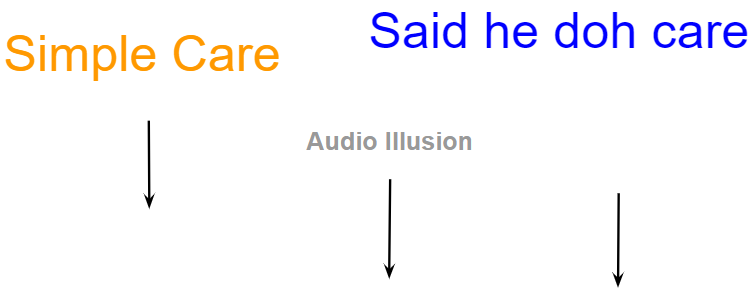Simple Care – Said he doh (don’t) care
Check Out The Audio Illusion
Said he doh care – simple care




Here is an example of two phantom phrases in the audio clip above.
Listen to the phantom speech illusion.
Can you hear the difference?

What are Phantom Speech Illusions?
A phantom speech illusion is the illusion of hearing speech that can be interpreted in many different ways.
People either hear one phrase or another.
Sometimes it may just be a word change and not a complete phrase.
There are a few examples of this phenomenon.
Speech illusions can also be polyrhythmic.
What are Polyrhythmic Phantom Speech Illusions?
Polyrhythmic phantom speech illusions are a type of audio illusion that can make a person interpret words, phrases and sentences differently, based on the alternative rhythmic patterns of speech sounds that they hear.
It can also be quasi-polyrhythmic as it gives the impression of polyrhythmic speech.
The audio clip featured is an example of this phenomenon where ‘said he doh (don’t) care’ is in Trinidadian English.
Trinidadians do not always pronounce their ‘t’s when saying the word ‘don’t’, so this audio illusion is of a Caribbean English nature.
Illusions like these are considered phantom speech so that it cannot be confused with any other type of illusion.
For instance, speech illusions where people mistakenly hear chatter when there is none.
In the audio clip, said he doh (don’t) care is heard in a rhythmic pattern of 4 syllables and simple care is heard in a rhythmic pattern of 3 syllables.
Together they make up a quasi-polyrhythm.
Check out Sound Wonders & Speech Illusions to learn more about different known audio phenomena.

Sound Wonders & Speech Illusions
A beginners guide to the Science of Sound, Psychoacoustics, Linguistics & Phantom Speech Illusions.
Order on Amazon
The Key Ingredient
I believe that the true illusive quality of polyrhythmic phantom speech illusions is in the time domain of sound.
It can be very difficult to not pay attention to the interpretations of speech if it follows a certain rhythmic course.
It’s like the human brain just focuses on hearing one aspect of the sound it receives while ignoring all the rest.
Misconception
One misconception I’ve heard about polyrhythmic phantom speech illusions is that different recordings of speech samples are played at different time intervals to the listener which is the basis for the illusion.
Although it may be possible, it can be tempting to believe that such speech illusions are the result of that cause.
However, psychologists that study confirmation biases explain that what we perceive is the result of what we believe to be true.

How Perception Is Affected? Do We Really Hear As Good As We Think?
When I first heard the audio illusion in the clip at the top of this post, I was delighted and oddly satisfied.
Not everyone reacts the same when hearing a phantom speech illusion for the first time.
It can be a very interesting thing to observe the reactions of people debating what they hear or what they think they hear when listening to phantom speech illusions.
It reveals how people’s subliminal thoughts can affect the perception of speech.
There have been many studies documenting this phenomenon.
Final Thoughts
The field of psychoacoustics and linguistics which is the basis for this type of auditory occurrence is fascinating.

Sound Wonders & Speech Illusions
A beginners guide to the Science of Sound, Psychoacoustics, Linguistics & Phantom Speech Illusions.
Order on Amazon